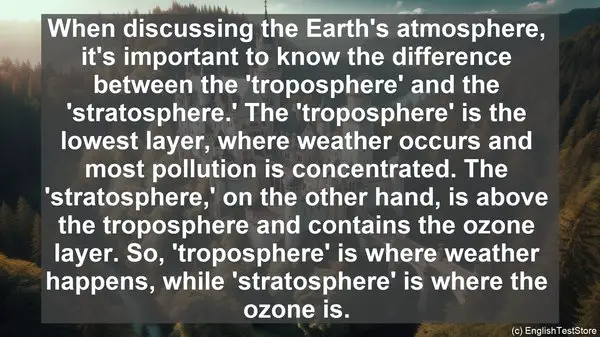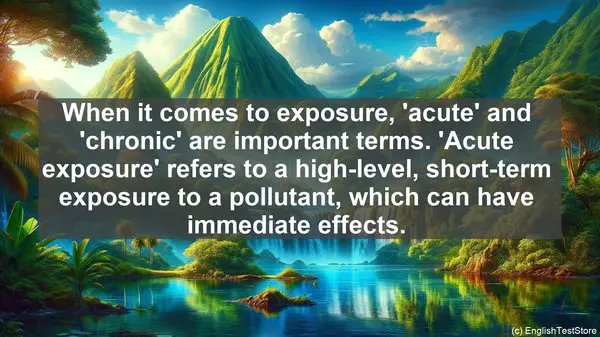Introduction
Welcome to today’s lesson on pollution ecology. In this lesson, we’ll be discussing the top 10 commonly confused words in this field. Understanding these words is crucial for a comprehensive grasp of pollution ecology. So, let’s dive in!
1. Emission vs. Immission
The first pair of words that often cause confusion are ’emission’ and ‘immission.’ While ’emission’ refers to the release of pollutants into the environment, ‘immission’ is the measurement or impact of those pollutants on a specific area or organism. So, ’emission’ is about the release, and ‘immission’ is about the impact.
2. Point Source vs. Non-Point Source
Next, we have ‘point source’ and ‘non-point source.’ A ‘point source’ is a single, identifiable pollution source, like a factory chimney. On the other hand, ‘non-point source’ pollution comes from multiple, diffuse sources, such as agricultural runoff. So, ‘point source’ is specific, while ‘non-point source’ is more scattered.
3. Bioaccumulation vs. Biomagnification
Moving on, ‘bioaccumulation’ and ‘biomagnification’ are often used interchangeably, but they have distinct meanings. ‘Bioaccumulation’ is the gradual buildup of pollutants in an organism’s tissues over its lifetime. ‘Biomagnification,’ on the other hand, refers to the increasing concentration of pollutants as they move up the food chain. So, ‘bioaccumulation’ is within an organism, while ‘biomagnification’ is between organisms.
4. Primary vs. Secondary Pollutants
Now, let’s talk about ‘primary’ and ‘secondary’ pollutants. ‘Primary pollutants’ are directly emitted into the environment, like smoke from a car’s exhaust. ‘Secondary pollutants,’ on the other hand, are formed through chemical reactions in the atmosphere, such as smog. So, ‘primary’ is direct, while ‘secondary’ is a result of reactions.
5. Acute vs. Chronic Exposure
When it comes to exposure, ‘acute’ and ‘chronic’ are important terms. ‘Acute exposure’ refers to a high-level, short-term exposure to a pollutant, which can have immediate effects. ‘Chronic exposure,’ on the other hand, is a long-term, low-level exposure, which can lead to health issues over time. So, ‘acute’ is intense but short, while ‘chronic’ is prolonged.
6. Mitigation vs. Adaptation
In the context of pollution ecology, ‘mitigation’ and ‘adaptation’ are strategies. ‘Mitigation’ refers to actions taken to reduce or prevent pollution at its source. ‘Adaptation,’ on the other hand, focuses on adjusting to the existing pollution and its impacts. So, ‘mitigation’ is about prevention, while ‘adaptation’ is about adjustment.
7. Biotic vs. Abiotic Factors
When studying the impact of pollution, we consider both ‘biotic’ and ‘abiotic’ factors. ‘Biotic factors’ are living organisms and their interactions, while ‘abiotic factors’ are non-living components, like temperature or pH. So, ‘biotic’ is about the living, while ‘abiotic’ is about the non-living.

8. Remediation vs. Restoration
Next, let’s differentiate between ‘remediation’ and ‘restoration.’ ‘Remediation’ is the process of cleaning up a polluted site, often by removing or neutralizing the pollutants. ‘Restoration,’ on the other hand, goes beyond cleaning and aims to bring the site back to its original, pre-pollution state. So, ‘remediation’ is about cleaning, while ‘restoration’ is about full recovery.
9. Troposphere vs. Stratosphere
When discussing the Earth’s atmosphere, it’s important to know the difference between the ‘troposphere’ and the ‘stratosphere.’ The ‘troposphere’ is the lowest layer, where weather occurs and most pollution is concentrated. The ‘stratosphere,’ on the other hand, is above the troposphere and contains the ozone layer. So, ‘troposphere’ is where weather happens, while ‘stratosphere’ is where the ozone is.

10. Point vs. Non-Point Load
Lastly, let’s clarify ‘point load’ and ‘non-point load.’ ‘Point load’ refers to pollution coming from a single, identifiable source, like a pipe discharging wastewater. ‘Non-point load,’ on the other hand, is pollution from multiple, diffuse sources, such as runoff from a construction site. So, ‘point load’ is specific, while ‘non-point load’ is more scattered.
